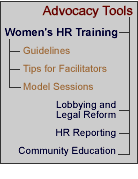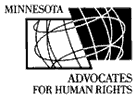|
|
GOALS AND OBJECTIVESEach training session should have a clear goals statement which introduces the concepts that will be delivered in the session – in general terms, an answer to the question “why is this session occurring?”, for example, ‘To define the concept ‘violence against women’ or ‘To facilitate an understanding of the variety of human rights legal instruments for addressing violence against women’. The model session contains example of a goals statement presented in the facilitator’s [introduction to the session] [link to the model session “What is Gender-Based Violence intro]. The next step in developing a training program is to identify the training objectives. The training objectives should be based on the findings of the needs assessment and the goals statement. They should be the central focus of the facilitator's preparation and should be explained clearly to the participants. Clarifying these objectives will aid in the process of selecting the appropriate content and structure for each session. A learning objective is the response expected from the participant. It is not:
Criteria For Developing Learning Objectives The learning objectives should [be]:
Writing The Learning Objectives 1) Begin the objective with a statement of the expected result, e.g. "As a result of this session, the participants will be able to…" 2) Select the appropriate verb - be sure to use an action verb, e.g. identify, write, organize, utilize, create, define, apply, analyze, conduct, evaluate, develop. 3) Complete the learning objective with the content of the relevant course segment, e.g. "As a result of this session, participants will be able to create an effective training program." The model sessions on gender-based violence contain more examples of [training objectives]. [link to model session “What is Gender-Based Violence” training objectives] What is a Training | Needs Assessment | Goals and Objectives Organizing a Training Workshop | [Preparing the Training Program] | Conducting Exercises | [Training Methods] | Tips for Facilitators | [Model Sessions] | [Final Remarks] [Guidelines for Developing a Training Program] |
| Home | Contact | Feedback | Disclaimer |

